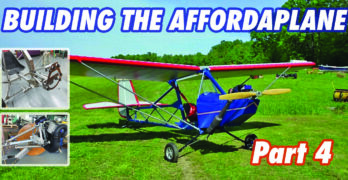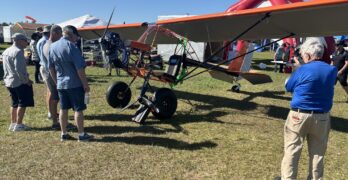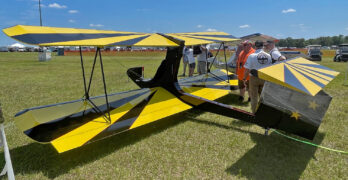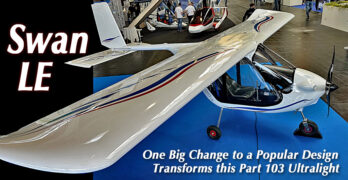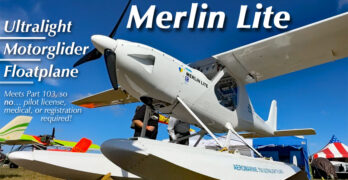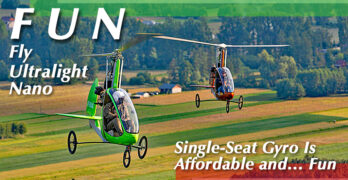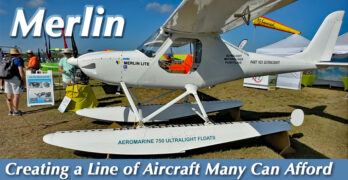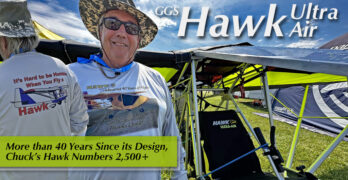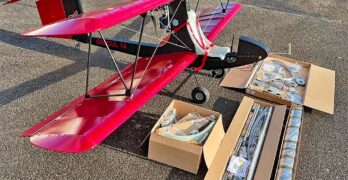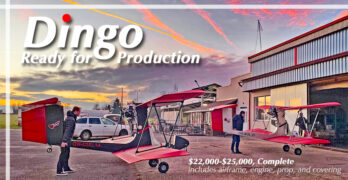With this, the last chapter of the Affordaplane build, I will describe how an engine mount was created to complete the last major step. As a quick recap of the previous chapters in this series, I was attempting to plans build a legal ultralight using common tools and store-purchased materials. For example: No welding allowed! So, now the biggest challenge confronting me was creating an engine mount needed for the engine installation.
First, what engine should be used in this project? This decision could not be made until we were nearly finished with the entire project. Why? The choice of engine is determined by how much weight remains after deducting the aircraft’s total weight from the 254-pound limit imposed by the FAA ultralight regulations. With the wings and tail attached to the fuselage, I weighed the entire structure. Without an engine, the scales read very close to 200 pounds.
Search Results for : Polini
Not finding exactly what you expected? Try our advanced search option.
Select a manufacturer to go straight to all our content about that manufacturer.
Select an aircraft model to go straight to all our content about that model.
Top Rudder — Have It Your Way
Top Rudder Aircraft, maker of the new Solo (Part 103) and Ruckus (LSA) aircraft, has one of the hottest booths at this year’s Sun ‘n Fun.
The company sold six of 10 available slots it had for planes in 2024 before the show opened on Friday. Both planes are based on a Troy Woodard design that had been around for a while, but it was only three months ago that Bryce Angel started Top Rudder to make these ultralight and light sport variants.
“It’s designed like a 1300-pound aircraft that’s we’ve modified for two entirely different kinds of flying,” explains Top Rudder’s Chief Engineer George Boney. “It can handle up to 200 hp, but our standard Polini 303 allows for stall speeds under 20 mph and a cruise of 50 for ultralight flying. Or, you can add another fuel tank, a slightly larger engine and tires and have an inexpensive backcountry sport plane that has real STOL capabilities.”
In its sport configuration with the Polini, the plane weighs about 350 pounds and is capable of limited acrobatics.
Dingo—a Single Seat, Open Cockpit Biplane
On display in Paradise City (the show’s area for light planes and ultralights) are a pair of “Dingos” – a relatively new ultralight kit design from Future Vehicles, a manufacturer located in the Czech Republic (futurevehicles.eu/dingo). The Dingo is a single seat, open cockpit biplane weighing in at approx. 210 lb without engine. The airframe is riveted from sheets made of aluminum 6061 and 2024 alloys. The ailerons and elevator are operated by rods and the rudder is controlled by cables. All sheet metal parts are already drilled and it is only necessary to rivet them (matched-hole technology utilized). The construction manuals with breakdowns and part numbers are in PDF format and are available on their website for public viewing. Also, videos of each stage of construction, showing the proper sequence of assembly, are provided on the Future Vehicles website.
Rick Bennett, of Bluff City Aircraft LLC (bluffcityaircraft.com) is the US distributor for the Dingo.
AVI’s Affordable, Foldable, Composite Part 103 Ultralight Aircraft Gets a Fresh New Look
Aeromarine LSA’s Chip Erwin is one but certainly not the only busy fellow in the modern Part 103 aircraft space. AVI’s Radu Berceanu is another a man on the move. Chip works in metal. Radu works in composite. You know Chip better (he’s adept at PR) but you probably know Radu’s designs. Readers have responded enthusiastically to articles and videos about Swan.
In an earlier article I promised a video look. Now that the flying season is easing into the holidays, I have more time to spend editing videos. What takes a few minutes to shoot takes hours to edit but I’m pleased to let you hear from Radu himself. His English is quite good and you get a lot of views of the new & improved Swan, now called Swan LE.
Fresh Swan Retake
The article from April this year had additional detail for Swan LE and mentions Dracula, the subject of a future video and article.
It’s What!? “It’s an …Ultralight Motorglider Floatplane,” and Many Can Afford It
In 2021, Merlin Lite lit up cyberspace after I wrote about the new entry’s introduction at Midwest LSA Expo in Mt. Vernon, Illinois. So many tens of thousands of you wanted to read about this intriguing aircraft that I worried the website could crash.
A few other airplanes have drawn large numbers of readers but Chip Erwin creations seem to do that with regularity. Most companies I write about struggle to come up with something new each year when we greet each other at airshows.
Contrarily, Chip is so bubbling with new ideas and excitement about them that he can barely talk fast enough to get all the words out of his mind. He’s always an exciting interview and a new video below offers another.
Why a…
Ultralight-Motorglider-Floatplane?
Following is what Chip has to say about his new creation. This is not identical to what’s in the video, so you want to read the following plus catch the video to learn more.
“Charming” and Affordable, Part-103 JK-2 Nano Now Propelled by 50-Horsepower Engine
“When I roll up to the terminal on any airport, it never ceases to amaze me how a small crowd will gather around the aircraft. Happens almost every time,” said Jeffrey Boyd, importer of the JK-2 Nano single-seat gyroplane. “They just think it looks cute and different. Then they find out it’s quite affordable.”
I reflected back that this cleanly executed Nano had the same effect on me when I first saw it at AirVenture Oshkosh 2021. A glance at this eye-catching design, beautiful in its simplicity and compact in its features (see on trailer or in shipping crate) suggested to me that JK-2 Nano could find a market.
For more than a decade, interest in gyroplanes has been strong. After European designers took earlier American simple gyros and transformed them into sleek aircraft, a wider range of pilots looked at them more positively. However, those more elegant and feature-laden designs steadily rose in price.
Innovative, Versatile Merlin — a Video Series You Loved (because?) It’s Affordable
This Merlin has nothing to do with kids in colorful costumes seeking sweets from their neighbors. It does have to do with pilots liking interesting airplanes that they can fly over their neighbors… especially when they can afford the airplane.
In the last couple years, I’ve created videos with Merlin developer, Chip Erwin that have been among the most-watched on Dave Loveman‘s Light Sport and Ultralight Flyer YouTube channel. I interviewed numerous industry leaders like Chip in around 1,000 videos. The 50 most popular of those productions have been watched more than 10 million times.
In addition, when I write about Merlin on this website, lots of readers seem to love it.
So it’s hardly any wonder that I would be pleased to continue our Top 50 video series with one from just a couple of years ago. In a short time, it passed the 275,000-views mark. Since then, I did another on Merlin that went over well on my own channel (see below).
Never One to Be Humble, Hawk Ultra Air Is Looking Better Than Ever in its Fifth Decade
Named “Ultra Air,” the newest Hawk Single sounds like it might be Apple’s new laptop computer. In our analog world, Hawk Ultra Air is nearly the exact opposite… except it is a light aircraft. Many might say it’s “ultra” fun so, hey!, the model name works.
“Less is more” is also a phrase that might apply to both Hawk and Apple. Hawk Ultra Air looks lighter and slimmer by removing the fabric enclosure. Appearing lean and minimal has appeal to many consumers.
Forty one years after its splashy introduction, Hawks now number more than 2,500 aircraft, a fine accomplishment for any manufacturer but especially for one so modestly priced and significantly hand built.
Saying Hawk is “hand built” speaks to some of the work Bob Santom, and his son LB have done as they took over one segment of the Hawk lineage. They have laboriously reassembled some earlier aircraft making extensive notes and preparing for continued manufacture, but became better informed than when they started.
Future Vehicles s.r.o.
Future Vehicles created, builds, and delivers worldwide the charming Dingo, a modern version of a popular design from the ’60s (Hovey Whing Ding). Dingo is fun, super-affordable, and is easy to fly, operate, and maintain. Available in kit or ready-to-fly for a price you can probably afford!
Super-Affordable Part 103 Dingo (low $20,000s, complete) Enters Production
While you continue digesting FAA’s 318-page thriller on Mosaic, here’s a fun aircraft that does not have to spend even one minute meeting those new rules. I’ve written about the Part 103-compliant Dingo from Future Flight before (this article) but the delightful biplane is now entering production.
Tom Peghiny of Flight Design USA fame, wrote, “Jan Jilek is one of the design engineers of Future Vehicles as well as their test pilot. He is also a talented aerobatic performer. We flew together in a few planes while I was working in Sumperk, CZ [as a consultant to Flight Design].”
Dingo was created by Marek Ivanov. At the beginning of 2021, he showed the first 3D images to the Future Vehicles team. This is an experienced group that does a wide range of engineering work for a variety of aircraft producers.
Describing Dingo
Dingo’s airframe is primarily riveted 6061 and 2024 aluminum sheet.
- 1
- 2
- 3
- …
- 5
- Next Page »


